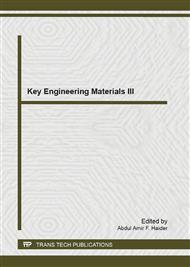p.329
p.333
p.337
p.342
p.349
p.354
p.359
p.364
p.370
Influence of Machining Parameters on Surface Roughness in WEDM Titanium Alloy
Abstract:
Wire electrical discharge machining (WEDM) is a material removal process of electrically conductive materials by the thermo-electric source of energy .This kind of machining extensively used in machining of materials with highly precision productivity. This work presents the machining of titanium alloy (TI-6AL-4V) using wire electro-discharge machining with brass wire diameter 0.25mm.The objective of this work is to study the influence of three machining parameters namely peak current (IP), feed rate (FC) and wire tension (WT) to material removal rate and surface roughness followed by suggesting the best operating parameters towards good surface finish. A full factorial experimental design was used with variation of peak current, feed rate and wire tension, with results evaluated using analysis of variance (ANOVA) techniques. Parameter levels were chosen based on best practice and results from preliminary testing. Main effects plots and percentage contribution ratios (PCR) are included for the main factors and their interactions. Peak current was shown to have the greatest effect on surface roughness (33% PCR).
Info:
Periodical:
Pages:
349-353
Citation:
Online since:
May 2013
Authors:
Keywords:
Price:
Сopyright:
© 2013 Trans Tech Publications Ltd. All Rights Reserved
Share:
Citation:


